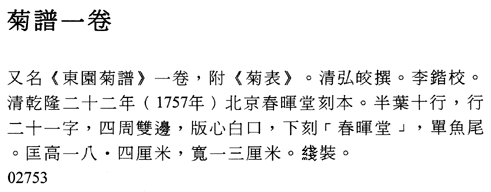|
|
|
|
 |
Manual on
Chrysanthemums, 1 juan Qing
dynasty (1644�1911), Qianlong period (1736�95) Compiled
by Hongjiao (18th century); proofread and edited by Li Kai (1686�1755) Beijing:
Chunhui tang, 1757 10
columns per half folio; 21 characters per column; white folding margin at
center of folio; double-line borders; overall dimensions of volume: 25.1 x 15.5
cm; block sizes of text: approx. 18.4 x 13.0 cm; stitched binding Inventory number: 02753 Chrysanthemums
(ju)
are native to China, where they have been cultivated since about 1000 b.c.e., with improved forms appearing
around 500 b.c.e.� Their gorgeous autumnal blooms have
long been celebrated in China, where they have been the subject of countless
poems, essays, and paintings as well as many specialized monographs. This
manual on chrysanthemums was compiled by Hongjiao, the fourth son of Yinxiang
(1686�1730), the first Prince Yi, and a grandson of the Kangxi emperor.� It lists and describes the salient features
of 100 types of chrysanthemums.� The
names of these horticultural varieties range from simple descriptive ones based
on color or shape to those evoking other flowering plants to those drawn from
historical figures or literary sources.�
The careful and detailed descriptions are helpful since the manual is
not illustrated.� In his
"Classification of Chrysanthemums," appended at the end of the manual,
Hongjiao divides the 100 varieties of chrysanthemums into 6 classes, namely the
shen
(divine), the miao (wonderful), the yi (untrammeled), the jun (outstanding), the yan (beautiful),
and the yun
(harmonious). |
 |
